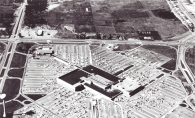Before the classic black-and-white squad cars began protecting the streets of Edina, Percy Redpath was the city’s one-man police department.
Edina, which was known as a village back then, purchased its first squad car in 1930, a Tudor Ford Sedan for $550, and employed Redpath as its first full-time paid officer. Redpath patrolled an average of 50 miles every night from 5 p.m. to 3 a.m., using five gallons of gas every shift and earning $104.17 per month. Things are a little different today. For one thing, the Edina Police Department (EPD) uses approximately 60,000 gallons per year on average.
Redpath would park the squad car at his home, 6300 Brookview Ave., which was also the police headquarters. Residents would call him on the village-approved phone line. If Redpath was on patrol, his wife, Mary Lena, wrote down the information for him to deal with later, since police radios were nonexistent at the time. If he went out, he would call the operator and tell her where to reach him, and if he was on patrol he would check in at a police call box with the Minneapolis dispatcher or stop at residents’ homes and ask to use their phone.
Today, an 800-megahertz radio system is used and allows for statewide communication. Edina Chief of Police Jeff Long, who has been on the job for 24 years, says this technology “would have been considered futuristic when I first started.”
Redpath kept a daily log of his activities in handwritten, hardcover journals. One year after he started, Redpath began working with a colleague when Officer Bob Mieske was hired to take the daytime shift.
Long describes the officers of old as being, “typical old-timer cops you would have envisioned in the ’60s and ’70s, who were compassionate people and good at their jobs. But they had a different mentality back then.”
He recalls hearing stories of officers stopping people for drunken driving, but instead of arresting them, the police would hide their keys in the weeds and tell them to walk home. “Or they would catch juveniles drinking and instead of issuing them a citation, the officers would just kick them in the seat of their pants and tell them not to do it again,” says Long. “That was they type of law enforcement that was acceptable at the time.”
Among the most profound changes the EPD underwent were the technological advances. Long remembers giving people tickets for not having their drivers licenses on hand, because he had no way of verifying their information, with a squad car equipped only with a radio and a light bar. “Today it’s truly more of a mobile office,” says Long. With a laptop computer, portable fingerprint reader, high-definition cameras and more, “information is easier to access and more streamlined.”
But even with all the new technology, old-fashioned police work still has an important place in today’s department. “We still get out and walk the beat,” says Sgt. Kevin Rofidal. “We might be full of technology but some of the best police work is just getting out of the patrol car. You don’t want to bury your face in a laptop.”
It wasn’t until 1942 that the squad finally moved into the basement of 4801 W. 50th St., its first official headquarters. In 1947 the department consisted of six officers, and grew to eight by 1955 when Chief Wayne Bennett was hired to head the department.
“Wayne Bennett set the stage for being proactive and on the leading edge,” says Marci Matson, executive director of the Edina Historical Society.
Bennett implemented numerous programs, several of which are still used today, such as a police liaison in schools (1965) and the Crime Prevention Fund (1970), which today sponsors programs such as Neighbors’ Home Watch, Operation I.D. as well as educational resources, special equipment purchases and the K-9 program.
One of the programs Bennett introduced in the 1960s was the “random patrol.” Using the spin of a handmade game wheel that determined where officers would patrol next, to keep criminals guessing by making patrols unpredictable.
“We were known nationwide,” says retired officer Jim Crawford. “We had a reputation as No. 1 in innovation in the entire state of Minnesota. You know we are pretty proud of that.”
Pride radiated through the department as a slew of firsts unfolded. In 1972 the first female police officer, Judy Hanson, was hired and worked as a police school liaison officer. This was the same year that saw the first K-9 unit, with officer Doug Madsen, who handled the dog, named Jet. And in 1978, Kris Eidem became the first female patrol officer.
In 1987 the dispatch center was updated with a new modern design, and all emergency, police, fire and medical operations were dispatched from one location. This system is still used today in Edina, one of the few cities in Minnesota that does so.
The EPD experienced its lowest moment during the FirStar Bank robbery of 2000. Officer Mike Blood was shot repeatedly, and he and officer Billy Moier were injured before Sgt. Scott Kuyper fatally shot the suspect in a residential neighborhood. The community rallied around their department.
In 2004, Edina’s new City Hall was designed with a state-of-the-art 911 communication center. Long says the building was a significant change. “My first office was a coat closet,” he says, adding that the old building had an old-fashioned jail with bars and clanging doors, as well as a single locker room and one employee restroom.
Throughout its history, the EPD has seen significant changes, but one thing has remained constant. “Our police department has always had a strong connection to the community,” Long says.
Menu
From the January 2014 issue
A History of the Edina Police Department
A stroll through the years at the Edina Police Department.
Percy Redpath, Edina's first police officer, patrolled the village in 1930 in his Ford Tudor sedan.
Photo by:









